Dreaming of becoming a full-time RVer? An 11-year veteran of the nomadic lifestyle shares the lessons she’s learned
Driving over the horizon to live in an RV full time was the best decision my husband, Mark, and I ever made, and our lives have been a thrill ever since. Choosing to become full-time RVers was a big decision, but the transition from living in a stationary home to one on wheels was surprisingly easy. Here are some of the things we’ve learned in 11 years of life on the road.
Plan Your Budget
The biggest question most would-be full-timers have is whether they can afford the lifestyle. The answer is yes. Full-time RVing is possible on any budget. It just depends on how fancy you wish to be.
See Related Story: Full-Time RVing Can Be a Full-Time Job
We have crossed paths with a very happy full-timing couple who made their home in a popup-tent trailer, as well as a single man who lived in his teardrop towed by a motorcycle. At the other end of the spectrum, we’ve met well-heeled travelers who reside in plush fifth-wheels and never think about their budget.
You can estimate day-to-day costs by looking at what you spend in your current lifestyle. Food, clothing and cell-phone expenses will be about the same, and satellite or cable-TV costs may be replaced with a mobile satellite-TV subscription. Homeowner-association dues, property taxes and a home mortgage or rent will be replaced with campground fees. Homeowner’s insurance will be exchanged for RV insurance, although the umbrella coverage for personal belongings that is standard with homeowner’s insurance is not available with RV insurance, even if it is a “full-timer’s” policy.
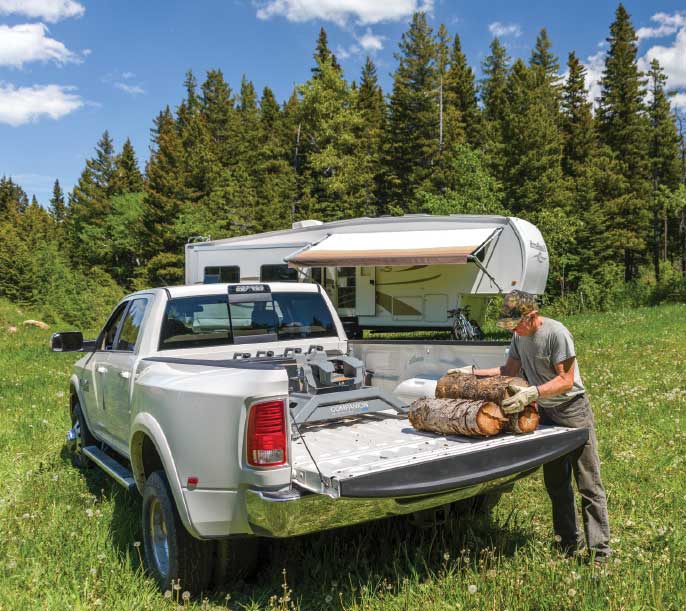
Heavy-duty hauler: Whether transporting logs or towing their fifth-wheel, the Fagans’ one-ton diesel gets a full-time workout.
Health insurance and the cost of medications may be similar. Check with your health-insurance provider to determine how best to receive medical care or medications on the road. Be clear on how filling an out-of-state prescription at a local pharmacy works. During your southerly winter travels, you can walk across the border to Mexico to buy medications, glasses or dental care at significant discounts.
For full-timers who tow their RV, repair costs and auto insurance for his-and-her cars will be replaced by repair costs and insurance for a single tow vehicle (or a motorhome and dinghy vehicle), and fuel costs will depend on how much you drive. We rack up from 10,000 to 20,000 miles each year in our truck, about half of that towing and half without the trailer. This is far less than we drove our two cars when we lived a conventional lifestyle.
When contemplating your full-time RVing budget, it is worthwhile to consider the costs of any hobbies you plan to pursue. A few years into your travels, you might want to upgrade to a new mountain bike or invest in expensive camera gear. The laptop computer, phone and tablet you start with will need replacing a few years down the road, or you might have a hankering to buy that amazing handcrafted guitar from the luthier’s workshop you just toured.
If you start with a brand-new trailer that has a warranty, and everything goes well, you’ll have few problems at first, and they’ll be covered by the manufacturer. However, a few years down the road, systems in the RV will begin to break. The financial blow of an unexpected repair can be mitigated by buying an extended warranty or setting aside some money for when the fridge dies, the air conditioner quits working or the slideouts decide not to budge.
Emergency repairs on the road may require you to find lodging while your RV is being worked on, so it is important to understand your RV’s insurance policy in relation to covering lodging. Also, sometimes it is difficult to get an appointment at a shop right away, and you may need to call around to find a shop that is available to work on your rig.
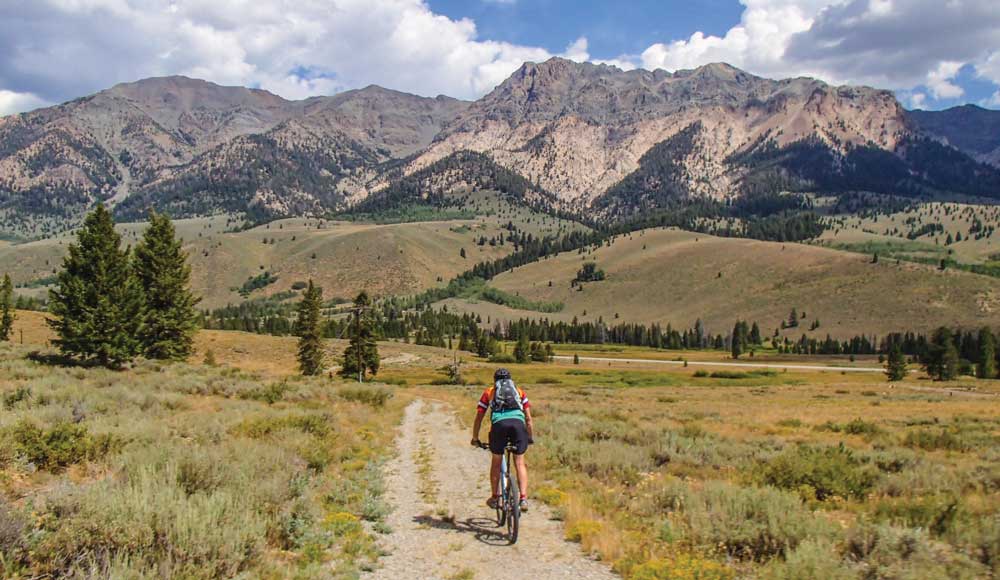
Author Emily Fagan and her husband, Mark, make the most of the full-time lifestyle to pursue their passion for bicycling. One of the first things they do in a new place is unrack their two-wheelers from the back of their fifth-wheel and saddle up for a ride.
Find Your New Home
There is no such thing as a right or wrong type of RV for full-time adventures, but, as you may expect, a higher-cost, better-built RV will likely hold up better under full-time use than a lower-cost base model. What matters most is that, when you’re in your RV, it feels like home.
However, there are things to look for when choosing a full-time RV. Make sure the cargo-carrying capacity can support everything you plan to take with you, including the weight in the freshwater tank if you plan to travel with it full. Everything you put in or on the RV adds weight, from hiking boots and winter coats to kitchen appliances, linens and bedding, tools and spare parts, bikes, barbecue, generator, solar panels, extra batteries and food.
Also, make sure the tow vehicle can pull the trailer with ease. In our experience, if the truck is towing at or near its maximum capacity, you will not be happy on the road. While flat roads in west Texas make for easy towing, the Rocky Mountains can be a scenic experience or a white-knuckle drive, depending on your ride. It’s a common mistake to start full-timing with a tow vehicle that is a poor match for the trailer, just as it’s common to find such setups among weekend RVers.
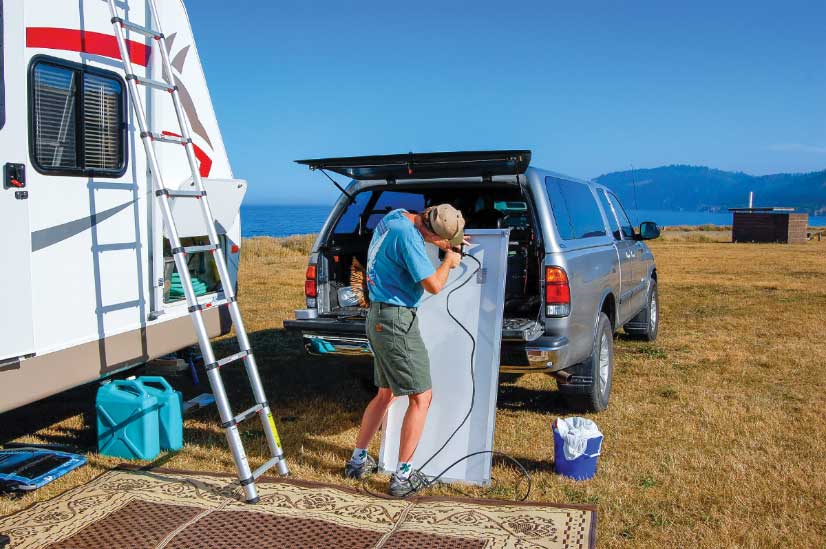
Household chores and improvement projects don’t go away when trading a stationary home for an RV, though there’s no lawn to mow and less floor to vacuum.
Downsize Your Possessions
The most daunting part of going full time is downsizing. Getting rid of a lifetime’s accumulation of stuff is hard work and can be emotional, too. You can hold an estate auction and have someone else sell off everything for you in one day, or you can host a series of yard sales and post items on Craigslist. Things that don’t sell can be donated to a thrift store.
We gave our most cherished belongings to friends and family, and now when we visit them, we enjoy seeing our goodies in their homes. Some people rent a storage unit, but if you figure the cost over several years’ time, it may not make financial sense compared to the value of the items being stored.
Sell Your House
Many full-timers put their house up for sale so they can purchase an RV with the equity. However, if the house is fairly rugged and in a good location, you may be better off leasing it, particularly if your timing doesn’t coincide with a sellers’ market.
We thought we sold our house, but the deal fell through just days before our full-timing launch. Rather than putting it back on the market and starting our travels with the house in limbo, we quickly found a tenant, and we’ve leased the house ever since. During 11 years of full-timing, we have had five different tenants, and because we’ve had time between tenants to work on the house while it was empty, it’s now in better condition than when we lived in it.
Being a landlord is not the first choice for many — it certainly wasn’t for us — but it is a viable alternative to selling. During the years that we’ve leased our home, rents have steadily increased, while home values in our neighborhood plunged a heart-stopping 50 percent after the 2008 financial crisis but are regaining lost ground.
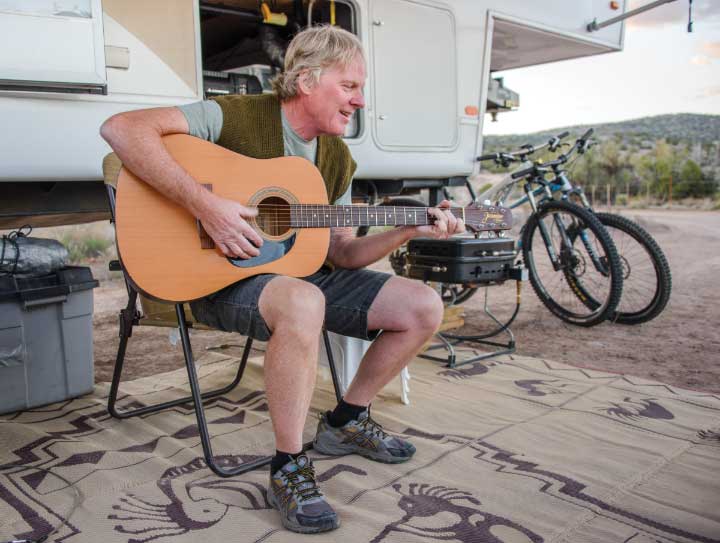
Hobbies like playing the guitar and riding rails-to-trails bike paths give shape and purpose to year-round travel.
Establish a Domicile
Once you hit the road, you will no longer have a permanent physical building to call home, but you will still need a home address, or domicile, for legal purposes. Many full-time RVers choose South Dakota, Texas or Florida as their home state because of low tax, license and insurance rates. Each of these states has companies that offer mail-forwarding services and
other assistance for full-time travelers. Among them, Americas-Mailbox (South Dakota), Escapees (Texas) and St. Brendan’s Isle (Florida) are popular.
Establishing a legal domicile can involve many subtleties. Some mail-forwarding companies will help with obtaining a driver’s license, registering and insuring vehicles, and registering to vote, all important steps in establishing state residency.
Map Your Path
Some full-timers travel between two favorite places, usually one in the south for winter and one in the north for summer. They may own a campsite at one or two private RV parks, or they may rent sites seasonally.
By doing so, they get to know each area in depth and have a stable social circle. Others prefer being on the go all the time, traveling from place to place and staying from a night to a month or more in each spot.
Full-time RVers often start off with constant travels and later settle into extended seasonal stays at their favorite destinations. Many hit the big national parks in the first year, and that is an ideal way to begin. However, constant sightseeing gets exhausting after a while. Developing travel themes and hobbies helps give your travels shape and purpose. Some RVers focus on doing iconic hikes all across the country or riding rails-to-trails bike paths.
We met one full-timer who converted a bunkhouse room in her fifth-wheel into an arts-and-crafts studio for scrapbooking and other projects. Others take their oil paints into the national forests to capture the beauty on canvas. Some instrumentalists go from one musical gathering to another, while NASCAR fans head to the tracks, baseball fans take in spring training, and history buffs visit Civil War battlefields.
We let our motivation take shape as we travel. A beautiful waterfall at the south end of the Blue Ridge Parkway inspired us to make waterfalls a theme as we followed the route north. Camping by a lake in Utah gave us the idea to seek out desert lakes and rivers in the Southwest for the next few months.
Keep in Touch
The internet has revolutionized full-time RVing. Our Verizon Jetpack MiFi uses cell-phone towers to access the internet, and the Jetpack, in turn, acts as a Wi-Fi hotspot for devices in our rig. A smartphone can be used as a hotspot in the same way. Banking, tax filing and other legal transactions can all be done on the internet, and Facetime and Skype add the intimacy of video chatting when calling loved ones.
Stay or Go?
RVing full time is a dream for many, and it is something we are extremely grateful to be doing. However, it’s not for everyone, and extended vacations and seasonal travel can be just as rewarding. But if wanderlust tugs at your soul and you long to break free from convention and try something exotic and new, then traveling down the winding road full time while towing your home behind you will change your life forever.
Places to Stay
Commercial RV parks can be found all across the continent. Most offer full hookups and include a laundry room, general store, recreational facilities and other amenities. Nightly fees can be high, but monthly and seasonal stays will lower the cost. Getting peak-season reservations in popular destinations can be challenging.
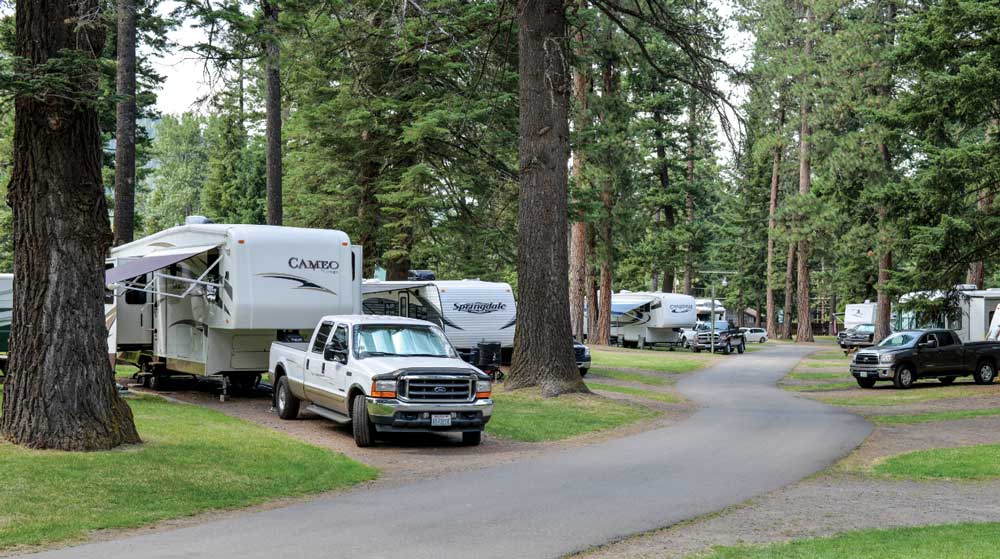
Parking under the pines is just one benefit of full-timing.
Campground membership programs can also reduce costs. Good Sam Club members save 10 percent on nightly stays at more than 2,400 Good Sam Parks. Passport America and the Happy Camper Club offer 50 percent discounts on camping fees at member parks.
Thousand Trails and Coast to Coast Resorts offer programs where a sizable membership fee at a home resort yields nominal camping costs at other resorts in those networks.
Members of Escapees RV Club can purchase or lease a site in a member park, enjoy discounts up to 50 percent at affiliate parks or stay on members’ properties for free.
Federal, state and municipal campgrounds often have beautiful campsites in natural settings, but most offer few amenities, and many have stay limits and restrictions on RV length. For those who enjoy an even more rustic setting, boondocking on public land is also an option, particularly if you have a solar system that allows you to stay off the grid.
Work Camping
There are many ways to work on the road and lots of support for RVers who are looking for part-time or seasonal work. Campground hosting and grounds-keeping are popular options. RV-park workers are usually paid a wage and given a full-hookup campsite, while compensation at government-run campgrounds may be limited to a campsite and a nominal stipend or none at all.
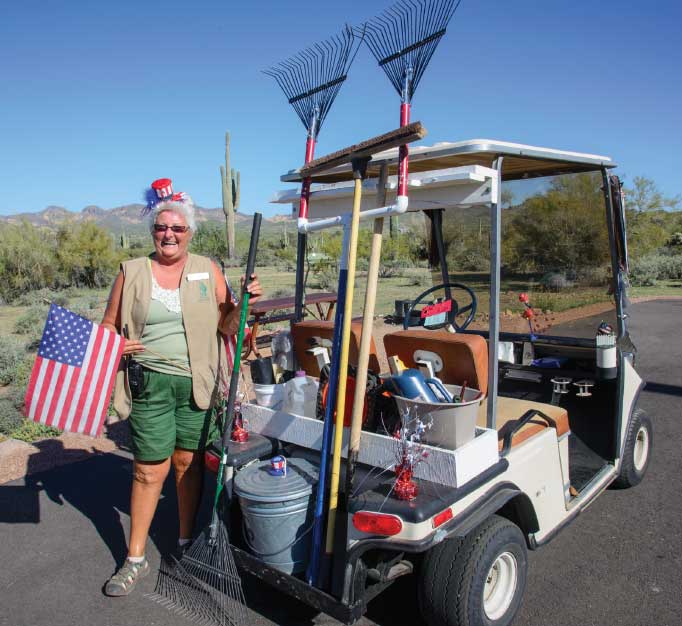
In exchange for various duties, seasonal campground hosts get a campsite free of charge.
Nurses can work short-term contracts, while consultants, software engineers, writers and photographers can take their professions on the road. Electricians and construction workers can find temporary jobs around the country, while internet-based businesses lend themselves to a mobile lifestyle.
Seasonal destinations need workers at gift shops, restaurants and attractions. Amazon CamperForce hires energetic RVers at the company’s warehouses for the four months leading up to the holidays, while oil fields and other properties need people to oversee the grounds.
Workamper and WorkingCouples host popular job-listing websites for RVers. Responding to help-wanted posts in tourist areas can also yield results. Just keep in mind that, while it may be refreshing to return to this kind of “summer job” after years of responsibility in the corporate world, it is also a big transition for professionals accustomed to higher-end working conditions to become hourly wage laborers.
columnist and frequent contributor Emily Fagan has traveled full time by RV and sailboat with her husband, Mark, since 2007. The couple’s photos have appeared on more than 25 magazine covers and wall calendars, and Emily’s lifestyle, travel and how-to articles have been featured in more than a dozen RV and sailing publications. Follow their adventures on their blog, Roads Less Traveled.

